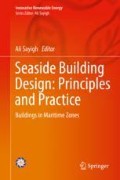Abstract
The actual levels of the ambient air temperature, solar radiation and wind can be modified by the design details of the outdoor spaces (Givoni et al. 2003; Al-Sallal 2016a). Air movement is considered one of the factors with special significance that is influencing thermal comfort. It is quite important, therefore, to study the effect of natural ventilation on outdoor thermal comfort and link it to different urban geometries. Moreover, and due to its major impact on building energy, ventilation plays a vital role in designing building systems, and it affects directly on the amount of building energy consumption. Ventilation is also required for breathing and removal of internally produced pollution and is used for cooling building structures especially in hot arid climates via night ventilation (Kazmerski et al. 1998). Seral issues will be discussed relating to ventilation in hot humid climate like UAE.
References
Abd Razak, A., Hagishima, A., Ikegaya, N., & Tanimoto, J. (2013). Analysis of airflow over building arrays for assessment of urban wind environment. Building and Environment, 59, 56–65.
Abd Razak, A., Rodzi, M. A. M., Jumali, A. H., & Zaki, S. A. (2015). Analysis of pedestrian-level wind velocity in four neighbourhoods in Klang Valley. Jurnal Teknologi, 76, 25–29.
Al-Sallal, K. A., & Al-Rais, L. (2011). Outdoor airflow analysis and potential for passive cooling in the traditional urban context of Dubai. Renewable Energy, 36, 2494–2501.
Al-Sallal, K. A., & Al-Rais, L. (2012). Outdoor airflow analysis and potential for passive cooling in the modern urban context of Dubai. Renewable Energy, 38, 40–49.
Al-Sallal, K. A. (2016a). Low Lnergy Low Carbon Architecture: Recent Advances and Future Directions, a book in the book series “Sustainable energy developments”. CRC Taylor and Francis Group.
Al-Sallal, K. A. (2016b). Passive and Low Energy Cooling. A chapter in K. Al-Sallal (Ed.), Low Energy Low Carbon Architecture: Recent Advances & Future Directions, (pp. 17–62). CRC Taylor and Francis Group.
Al Sabbagh, N., Yannas, S., & Cadima, P. (2016). Improving pedestrian thermal sensation in Dubai. In PLEA 2016 – 36th International Conference on Passive and Low Energy Architecture, Cities, Buildings, People: Towards Regenerative Environments, Los Angeles.
Architecture 2030. (2011). Architecture 2030 [Online]. http://architecture2030.org/. Accessed 1 Nov 2013.
Fan, M., Chau, C., Chan, E., & Jia, J. (2017). A decision support tool for evaluating the air quality and wind comfort induced by different opening configurations for buildings in canyons. Science of the Total Environment, 574, 569–582.
Geros, V. (2000). Ventilation nocturne: Contribution a la reponse thermique des batiments. Thèse, INSA, Lyon.
Givoni, B., Noguchi, M., Saaroni, H., Pochter, O., Yaacov, Y., Feller, N., & Becker, S. (2003). Outdoor comfort research issues. Energy and Buildings, 35, 77–86.
Global Footprint Network. (2010). Ecological footprint atlas 2010. http://www.footprintnetwork.org. Abgerufen am 4 Feb 2011.
Hong, B., & Lin, B. (2015). Numerical studies of the outdoor wind environment and thermal comfort at pedestrian level in housing blocks with different building layout patterns and trees arrangement. Renewable Energy, 73, 18–27.
Jamei, E., & Rajagopalan, P. (2017). Urban development and pedestrian thermal comfort in Melbourne. Solar Energy, 144, 681–698.
Johansson, E. (2006). Influence of urban geometry on outdoor thermal comfort in a hot dry climate: A study in Fez, Morocco. Building and Environment, 41, 1326–1338.
Kazmerski, L., Gallo, C., Sala, M., & Sayigh, A. (1998). Architecture: Comfort and energy. Oxford, UK: Elsevier Science.
Kharecha, P. A., Kutscher, C. F., Hansen, J. E., & Mazria, E. (2010). Options for near-term phaseout of CO2 emissions from coal use in the United States. Environmental Science & Technology, 44, 4050–4062.
Kubota, T., & Ahmad, S. (2005). Analysis of wind flow in residential areas of Johor Bahru City. Journal of Asian Architecture and Building Engineering, 4, 209–216.
Lai, D., Guo, D., Hou, Y., Lin, C., & Chen, Q. (2014). Studies of outdoor thermal comfort in northern China. Building and Environment, 77, 110–118.
Makaremi, N., Salleh, E., Jaafar, M. Z., & Ghaffarianhoseini, A. (2012). Thermal comfort conditions of shaded outdoor spaces in hot and humid climate of Malaysia. Building and Environment, 48, 7–14.
Milne, M. Climate Consultant Software. Los Angeles: Dept. of Architecture and Urban Planning, UCLA. http://www.energy-design-tools.aud.ucla.edu/
Rajagopalan, P., Lim, K. C., & Jamei, E. (2014). Urban heat island and wind flow characteristics of a tropical city. Solar Energy, 107, 159–170.
Rismanian, M., Forughi, A., Vesali, F., & Mahmoodabadi, M. (2016). Investigation of the effect of walkway orientation on natural ventilation. Scientia Iranica. Transaction B, Mechanical Engineering, 23, 678.
Santamouris, M. (2001). Energy in the urban built environment. London: James and James Science.
Santamouris, M. (2005). Energy in the urban built environment: The role of natural ventilation. Natural ventilation in the urban environment: Assessment and design, 1–19.
Santamouris, M., & Asimakopoulos, D. (1987). Passive cooling of buildings. London: James and James Science.
Santamouris, M. (2012). Energy in the built environment. A chapter in C. Ghiaus & F. Allard (Eds.) Natural ventilation in the built environment: assessment and design. London, UK.: Earthscan.
United Nations, Department of Economic and Social Affairs, Population Division (2014). World Urbanization Prospects: The 2014 Revision, Highlights. Internet: https://esa.un.org/unpd/wup/publications/files/wup2014-highlights.Pdf, ST/ESA/SER.A/352.
Wackernagel, M., Onisto, L., Bello, P., Linares, A. C., Falfan, I. S. L., Garcia, J. M., Guerrero, A. I. S., & Guerrero, M. G. S. (1999). National natural capital accounting with the ecological footprint concept. Ecological Economics, 29, 375–390.
Wikipedia. (2017). Climate of Dubai [Online]. Accessed 23 May 2017.
World Wildlife Foundation. (2010). Living planet report 2010: Biodiversity, biocapacity and development, Switzerland.
Yannas, S. (2001). Toward more sustainable cities. Solar Energy, 70, 281–294.
Author information
Authors and Affiliations
Corresponding author
Editor information
Editors and Affiliations
Rights and permissions
Copyright information
© 2018 Springer International Publishing AG
About this chapter
Cite this chapter
Al-Sallal, K.A., AbouElhamd, A.R. (2018). Natural Ventilation in Hot Seaside Urban Environments. In: Sayigh, A. (eds) Seaside Building Design: Principles and Practice. Innovative Renewable Energy. Springer, Cham. https://doi.org/10.1007/978-3-319-67949-5_3
Download citation
DOI: https://doi.org/10.1007/978-3-319-67949-5_3
Published:
Publisher Name: Springer, Cham
Print ISBN: 978-3-319-67948-8
Online ISBN: 978-3-319-67949-5
eBook Packages: EnergyEnergy (R0)

